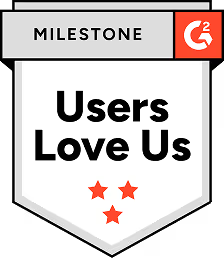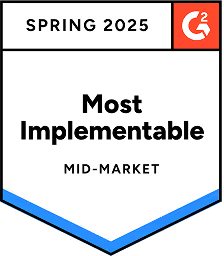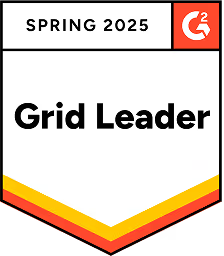State of Sales Development Report 2025: How AI is rebuilding outbound

TL;DR
B2B prospecting is at a breaking point. Our State of Sales Development Report 2025 reveals a growing gap between teams still operating on legacy systems and those modernizing around AI. While many sales orgs are working harder than ever, their pipeline performance shows the same underlying problem: disconnected tools, poor data, and manual processes that drain selling time.
This article unpacks what’s holding teams back, and what the top 18% of performers are doing differently. From system inefficiencies to AI adoption maturity, it offers a data-backed look at how sales development is evolving, and what modern prospecting will look like in the year ahead.
Key takeaways from the article:
- The pipeline gap is a systems problem, not a performance one: Many teams are missing quota not because their reps can’t sell, but because their systems make selling harder. Poor data quality (55%), time lost to admin work (up to 50% of a rep’s week), and lack of clarity in lead prioritization (25%) form a “doom loop” that keeps teams stuck.
- Tool sprawl is eroding efficiency: Almost half of sales orgs (46%) use 4-6 tools in their outbound stack, and another 21% juggle 7+. The result is fractured workflows and constant context-switching. Instead of driving efficiency, tech stacks have become a source of drag that limits selling time.
- Administrative work is eating into revenue potential: More than half of sales leaders say reps spend 20-40% of their week on admin tasks. For an $80K-a-year rep, that’s $16K-$32K of time lost to manual updates instead of selling. Only 1% of teams have fully eliminated this burden — usually through automation.
- AI adoption is widespread but not yet mature: Eighty percent (80%) of sales teams already use AI, but most still limit it to low-risk tasks like email drafting or data enrichment. Confidence — not capability — is the real barrier to deeper adoption. Teams that trust AI for scoring and prioritization are seeing measurable performance gains.
- 5. The top 18% of teams — those hitting or exceeding quota — have fixed their foundations: High performers aren’t working harder; they’ve built smarter systems. They’ve cleaned their data, consolidated their tools, automated admin work, and embedded AI across workflows. Sixty-two percent (62%) of those using AI report significant or game-changing impact.
Every sales leader knows the feeling: your team is working harder than ever, but the pipeline isn't keeping pace. Reps are busy (logging activities, updating records, researching accounts) but somehow spending less time actually selling.
It's not a motivation problem: it's a systems problem.
We surveyed 250+ sales leaders in tech to understand what's breaking down in modern prospecting and what the highest-performing teams are doing differently. What emerged is a picture of an industry in transition: old workflows collapsing under their own weight, AI moving from nice-to-have to competitive necessity, and a widening gap between teams that have adapted and those still running the old playbook.
{{cta-1}}
The pipeline problem is bigger than you think
Pipeline performance looks steady on the surface, but the numbers tell a different story. Many teams are holding the line, yet a growing share are falling short — and the reasons have less to do with effort and more to do with how their systems work.
The good news, and the bad news
When it comes to pipeline generation, almost half of respondents (44%) said their sales teams are meeting their targets. Another 18% reported that they’re hitting or even exceeding them.
The bad news: just over a third (38%) admitted their teams are falling short — leaving revenue on the table.
If you're in that group, you aren’t alone. But the question is: why is this happening?
What’s really behind the pipeline gap
The answer lies in three interconnected problems that compound each other: data quality, efficiency, and clarity.
- Data quality. More than half of leaders (55%) cited it as a top-three concern — and for good reason. When your contact information is outdated, your firmographic data is incomplete, or your intent signals are unreliable, reps waste time chasing dead ends.
- Efficiency. Just over half (~58%) of respondents said admin tasks take up to 30% of a rep’s week. About one-third (~33%) said admin consumes 40–50% of rep time, and another ~10% said it’s 60% or more. Only ~1% of teams reported zero admin burden — proving it’s possible, but rare.
- Clarity. A quarter of leaders (25%) said that lead prioritization is their biggest workflow friction point. Without reliable data and with limited time, reps are essentially guessing about who to contact and when.
Together, these issues create a doom loop. Bad data makes prioritization impossible. Poor prioritization wastes the limited selling time reps have. And when tools don’t integrate, reps spend even more time on admin instead of fixing the data or improving their targeting.
For the 18% hitting their numbers, the difference isn’t that they’re working harder. It’s that they’ve broken this loop by fixing their systems.
{{cta-1}}
AI isn't the “future” of outbound: it's already the reality
AI has officially crossed the threshold from experiment to everyday tool. What once felt optional has become essential, and the data proves it: adoption is widespread, performance gains are measurable, and the gap between teams using AI and those avoiding it is widening fast.
Where AI is already winning
Four out of five sales teams (80%) are already using AI in prospecting, and it’s now outperforming traditional cold outreach.

AI-powered sequences and outreach agents (48%) now outrank every cold channel — ahead of LinkedIn DMs (46%), cold calling (45%), and cold email (37%).
That shift marks a clear turning point. AI-powered outreach is now more effective at generating pipeline than the manual tactics most teams have relied on for years.
That doesn’t mean human connection is less important. Warm, trust-based channels still lead the pack: partner and referral programs sit at 68%, and inbound follow-up at 54%. Those win because they start with intent and credibility.
But for cold outbound, where you’re starting from zero, AI has become the best way to break through.
What leaders say will move the needle next
When leaders were asked what they believe would most improve pipeline generation for their teams, the top answers weren’t “more calls” or “more emails.”

Instead, they pointed to better prospect data (28%), stronger intent signals (22%), and more personalized messaging (21%) — followed by more warm leads (18%). “More time dialing” trailed at just ~11%.
The emphasis is clearly on quality inputs, not quantity of activity.
The bottom line: pipeline growth isn’t about doing more of the same. It’s about better-targeted, higher-quality outreach — and AI is proving it can deliver that more effectively than manual outbound ever has.
{{cta-1}}
Your tech stack is probably slowing you down
As stacks grow, point tools that once solved real problems start to create drag: more tabs, more copy-paste, more “did that sync?” Instead of freeing up time, they chip away at it.
You feel it in the day-to-day: switching windows to trigger the next step, reconciling fields that don’t match, retracing who touched what and when. Each tool is great at one thing, but together they create handoffs and guesswork. Reps end up shepherding records instead of advancing conversations.
The survey data backs that up.
Stacks are getting deeper & deeper
Most sales teams are managing more tools than they can meaningfully use, and it’s starting to show up in their day-to-day work.

About 46% of sales orgs use 4–6 tools in their outbound stack, and another 21% juggle 7+ in their day-to-day workflows.
That leaves about one-third (33%) that only use about 1-3 tools, and then a small but notable 6% of teams that reportedly run 11+ tools across their prospecting motion.
On paper, more tools should mean more capability. In practice, it means more time lost to switching tabs, reconciling fields, and wondering which platform holds the most current data. Every new point solution adds another layer of friction, leaving reps managing systems instead of conversations.
It’s a classic case of “too much of a good thing.” The tools themselves aren’t the problem: the lack of connection between them is.
Decisions are top-down
If your tech stack feels disjointed, there’s a reason. In most organizations, the people choosing the tools aren’t the ones using them.
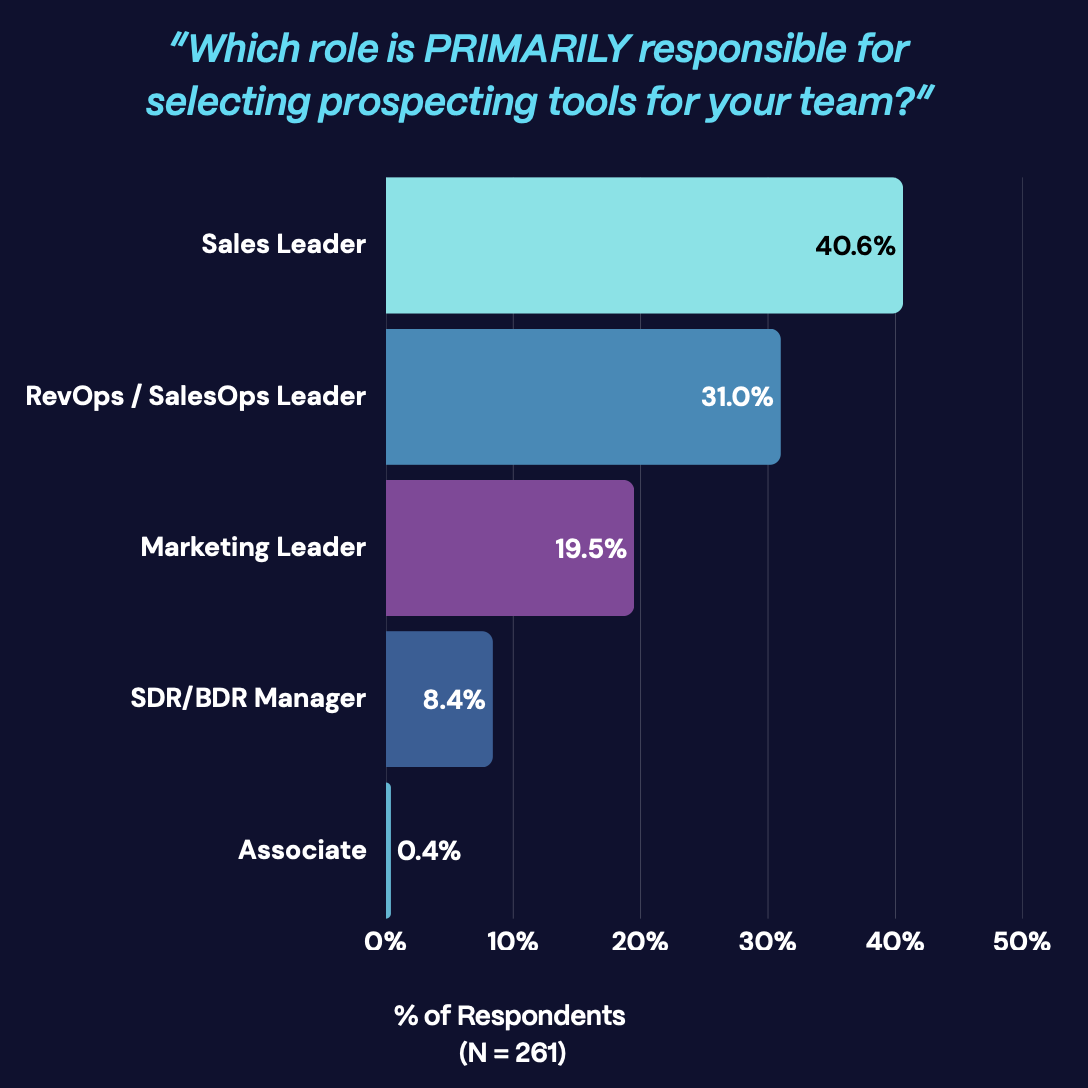
Roughly 91% of tech stack decisions come from department heads — sales, revOps, or marketing — while only 9% include input from SDR or BDR managers and the reps closest to the work.
That gap matters. Leaders select tools based on features that look good in demos, not on how they perform in the daily rhythm of outreach. The result is familiar: software that promises efficiency on paper but adds friction in practice.
It’s not a lack of intent; it’s a lack of inclusion. When the people running the sequences, cleaning the data, and logging the calls aren’t in the room, it’s easy to mistake activity for progress.
We’ll unpack the time tax in the next section.
{{cta-1}}
The real cost of administrative burden
Your tools were supposed to make selling easier. Instead, they’ve made it harder. Every disconnected system adds a few more clicks, a few more minutes, and a few more reasons why reps spend less time actually selling. That’s where the real cost shows up — in time, productivity, and pipeline.
The time tax is real
Across the board, reps are spending a surprising amount of time on work that isn’t selling.
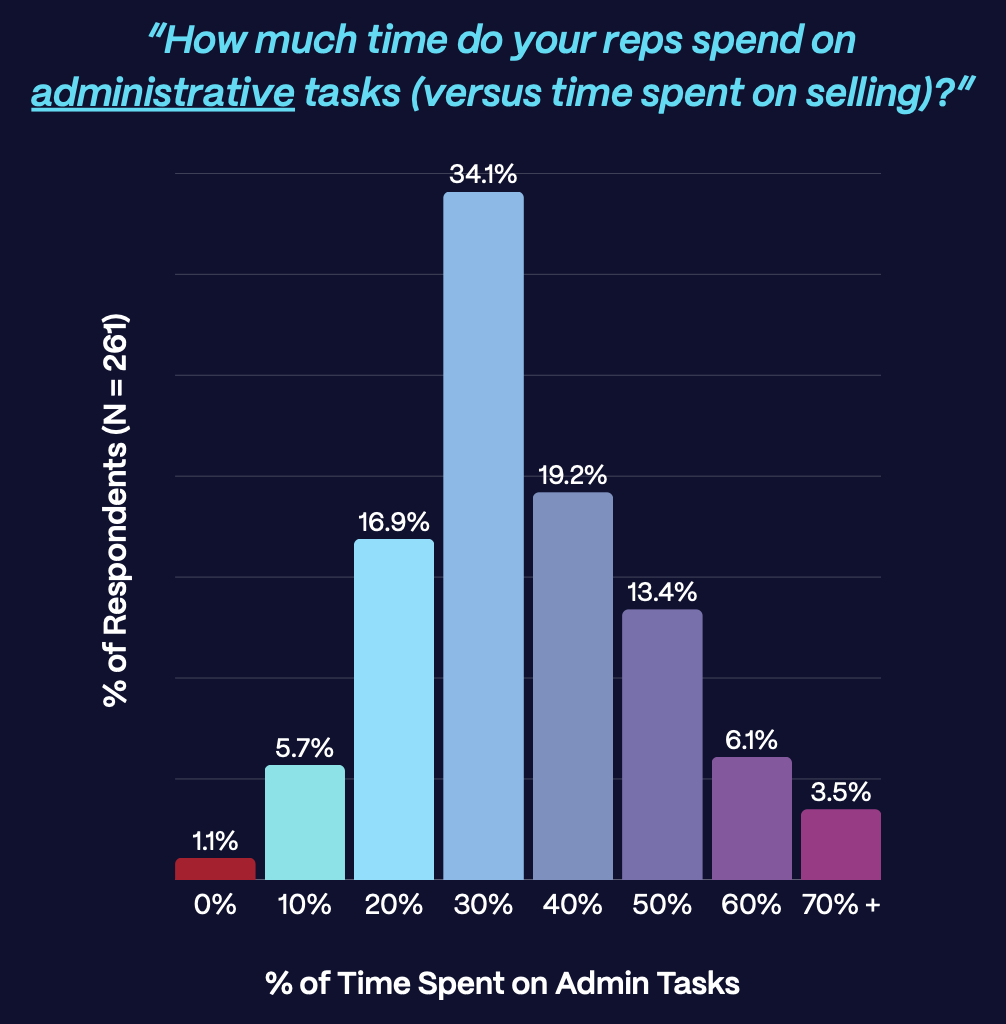
More than half of sales leaders (58%) say admin tasks take up to 30% of a rep’s week, and another one-third (33%) report that admin consumes 40–50% of their reps’ time.
Only about 1% have managed to eliminate it entirely — proof that it’s possible, but rare.
If you do the math, that means for an $80K-a-year rep, $16K–$32K of that salary effectively goes toward updating records and managing systems instead of generating revenue. That’s a massive opportunity cost, and one that compounds across every seller on the floor.
Where the drag comes from
This administrative burden shows up as workflow friction across the board.

When we asked leaders what’s slowing their teams down, lead prioritization topped the list at 25%, followed closely by tool integration (23%) and manual data entry (22%).
Each issue may sound different, but together they paint a consistent picture: disconnected systems and low-quality data are stealing time from selling.
Why workarounds don’t work
How are teams dealing with this? Instead of fixing the root problem, many teams are working around it.
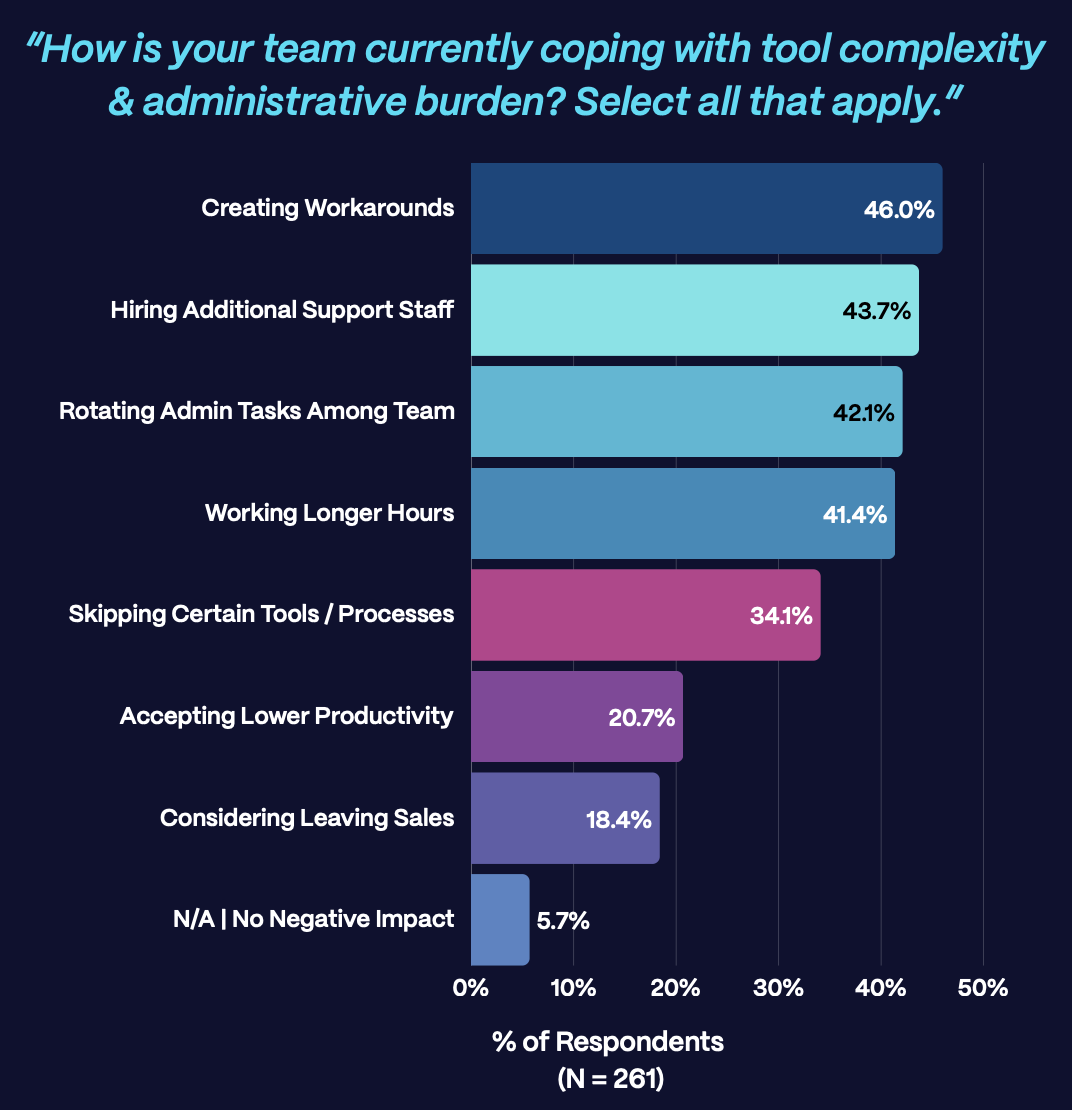
Nearly half (46%) have built manual workarounds to patch broken systems. Another 44% have added support staff, 42% rotate admin tasks, and 41% are simply working longer hours.
These efforts are just band-aids, though. When you hire more staff to handle admin work, you're paying to maintain a broken system instead of fixing it. When you rotate tasks or work longer hours, you're spreading the dysfunction around instead of eliminating it.
The downstream effects are predictable. A third of teams (34%) say reps are skipping certain processes entirely just to keep up. A shocking 18% say reps are considering leaving sales altogether.
When you're losing talent because your systems make the job harder than it needs to be, that's not an efficiency problem: that's an existential one. And it ties directly back to those pipeline numbers: the 38% missing quota aren't failing because their reps can't sell. They're failing because their reps don't have enough time to sell.
{{cta-1}}
AI adoption is widespread, but not yet mature
AI has reached a tipping point in sales development. What started as an experiment to “see what’s possible” is now a core part of how teams plan, execute, and measure outbound. But widespread adoption doesn’t necessarily mean maturity. Most organizations are still figuring out how to operationalize AI effectively — and how to build the trust, infrastructure, and confidence required to make it scale.
The pressure is on
AI has officially moved from experiment to expectation.
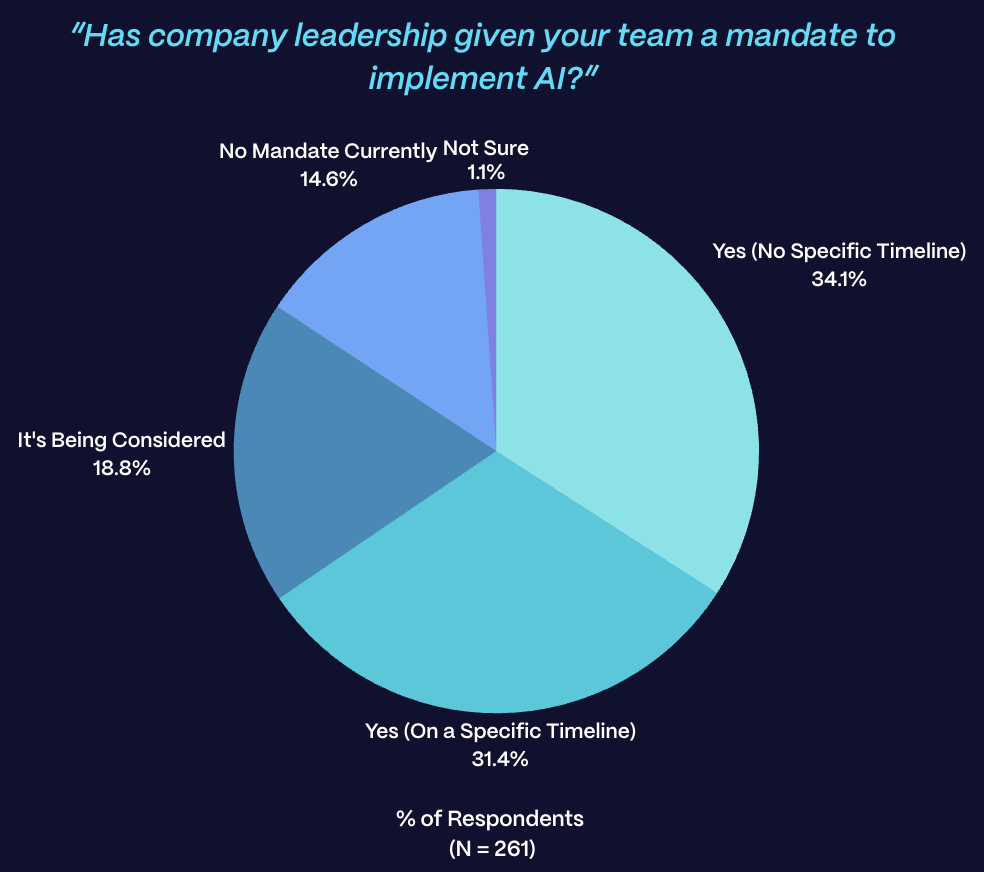
Two-thirds of companies (66%) now have a formal AI mandate, and about one-third (31%) are working against a defined timeline. Another 19% are still considering it, leaving only a small minority (~15%) without a mandate at all.
The takeaway is clear: everyone knows AI is coming; the only question is how quickly they’ll operationalize it.
And adoption urgency is being fueled from every direction.

Inside organizations, productivity goals (61%) top the list of pressures as leaders look for ways to do more with leaner teams.
Externally, competitive pressure (48%) and industry trends (48%) make delay feel risky, while cost reduction (38%) and executive directives (29%) add top-down urgency.
The result? AI adoption is no longer a curiosity: it’s a performance expectation.
Early wins show real impact
The teams that have already started adopting AI are mainly using it to go after low-hanging fruit activities.

Specifically, the majority are using chatbots or outreach agents (68%) and AI email writing (65%), quick wins that automate busywork and accelerate personalization. Many have expanded into call summarization (48%) and lead scoring (43%), which require deeper integration and greater trust. Only about one in five (20%) have taken the leap into AI dialers, signaling that full workflow-level automation — especially in live conversations — remains a frontier.
And for teams that have already integrated AI into their prospecting workflows, the payoff is real and tangible.
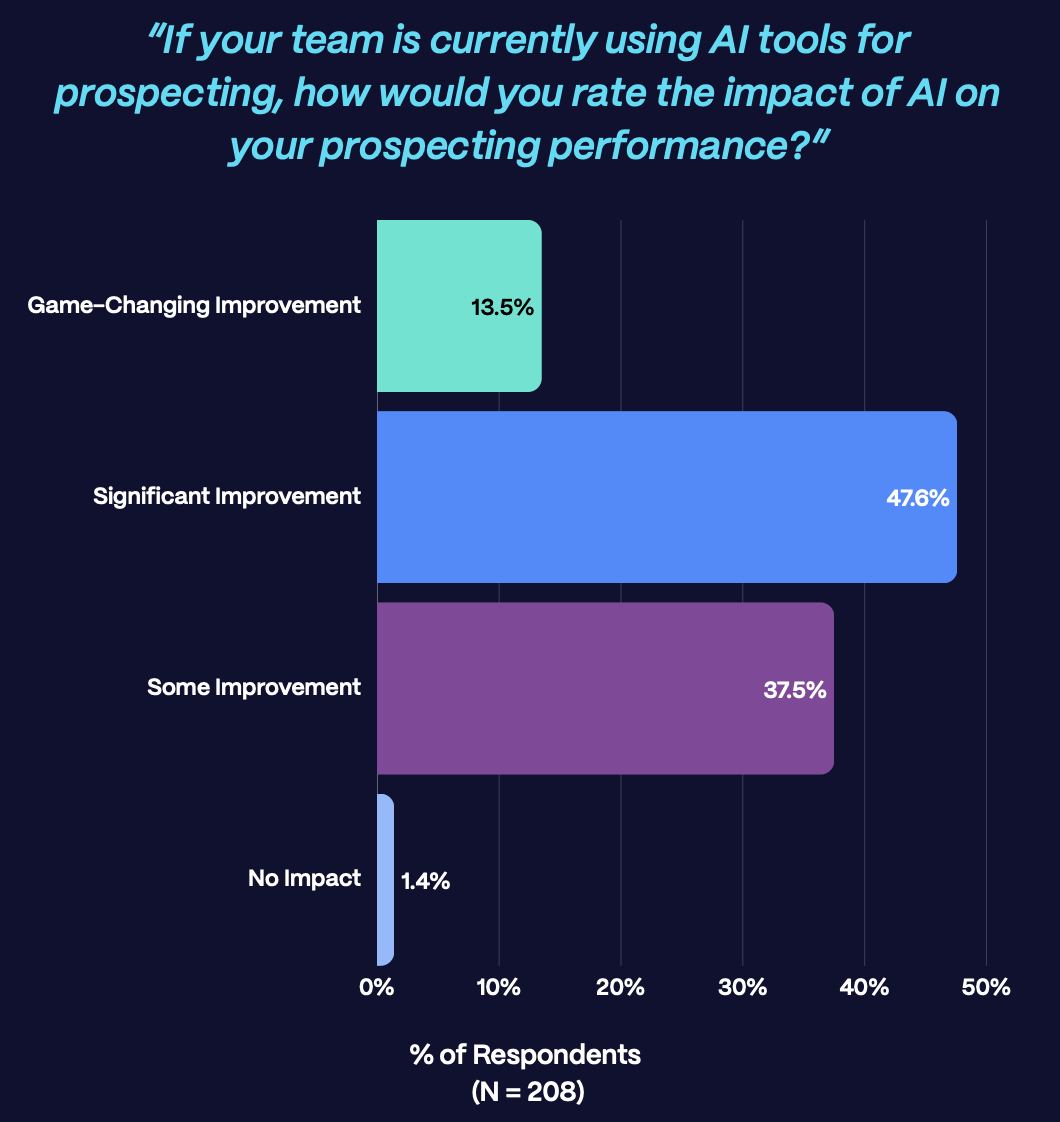
Nearly two-thirds (62%) report significant or even game-changing improvement in performance, while only 1% say it made no difference.
Those results suggest AI is already driving real productivity and pipeline gains. It isn’t a “future of sales” promise anymore; it’s a present-day differentiator.
{{cta-1}}
But confidence (not capability) is the real barrier
AI’s biggest obstacle isn’t technical: it’s cultural. Even as adoption grows, many teams remain unsure how to evaluate tools, roll them out, or trust them in the moments that matter most.
The technology is ready. The hesitation lives in the organization: competing priorities, uncertain leadership buy-in, and lingering doubts about what AI can safely take on.
The result is a slow roll toward maturity — not because the tools aren’t ready, but because organizations aren’t.
Why teams hesitate
For the ~20% of teams not yet using AI, hesitation starts at the top.

Leadership approval (21%) remains the biggest blocker, followed by uncertainty about which tools to choose (19%) and limited technical expertise (15%). Budget (6%) ranks near the bottom, showing that cost isn’t the true constraint.
Beneath those numbers, softer concerns — fear of losing the human touch (13%), data privacy (9%), and trust in AI reliability (9%) — add another layer of caution.
Where evaluation gets stalled
And even once leadership green-lights exploration, progress can stall in the evaluation phase.

Choosing between dozens of tools, each claiming seamless integration and instant ROI, introduces its own complexity. Leaders say integration challenges (28%) top their list of headaches, followed by lack of internal expertise (20%), budget constraints (20%), and unclear ROI (17%). Another 15% point to “too many vendors” as a barrier in itself.
These aren’t reasons to avoid AI: they’re signs that adoption maturity is bumping up against operational reality.
The through-line is clear: teams believe in AI’s potential but lack the confidence that their current systems, skills, and processes can support it. Until that trust gap narrows, decision cycles will stay cautious.
What leaders actually trust AI to do
Confidence — or lack thereof — shows up most clearly in how teams use AI today.

Most leaders are comfortable assigning it the back-office work: email drafting (54%), CRM updates (50%), data enrichment (47%), and call summaries (46%) — low-risk tasks that reclaim hours without touching the customer experience.
But that comfort fades fast when AI steps closer to the prospect.
Only 37% of leaders would trust AI to score leads autonomously, and just 22% would let it make calls. Those numbers suggest not resistance, but a boundary; AI has earned permission to assist, not authority to act.
Building confidence is key to internal buy-in
Confidence is the missing ingredient in AI maturity.
The tools are capable, the results are measurable, and the ROI is growing. And yet, leaders still need proof that AI can integrate cleanly, perform reliably, and enhance rather than replace the human connection that drives sales.
And that’s exactly what the top 18% of teams have figured out. They’ve learned how to deploy AI confidently — integrating it into their systems, workflows, and strategies in ways that compound productivity rather than complicate it.
In the next section, we’ll break down what those high performers are doing differently, and what their success reveals about where the industry is heading next.
{{cta-1}}
What the top 18% are doing differently
The gap between teams hitting quota and those falling short isn’t about effort. It’s about infrastructure. The top 18% of teams that are hitting or exceeding their goals have reengineered how they work. They’ve addressed the core issues — data, efficiency, and clarity — that hold most organizations back, and the results show up directly in their pipeline performance.
How top teams build their foundation
High-performing teams start with better data.
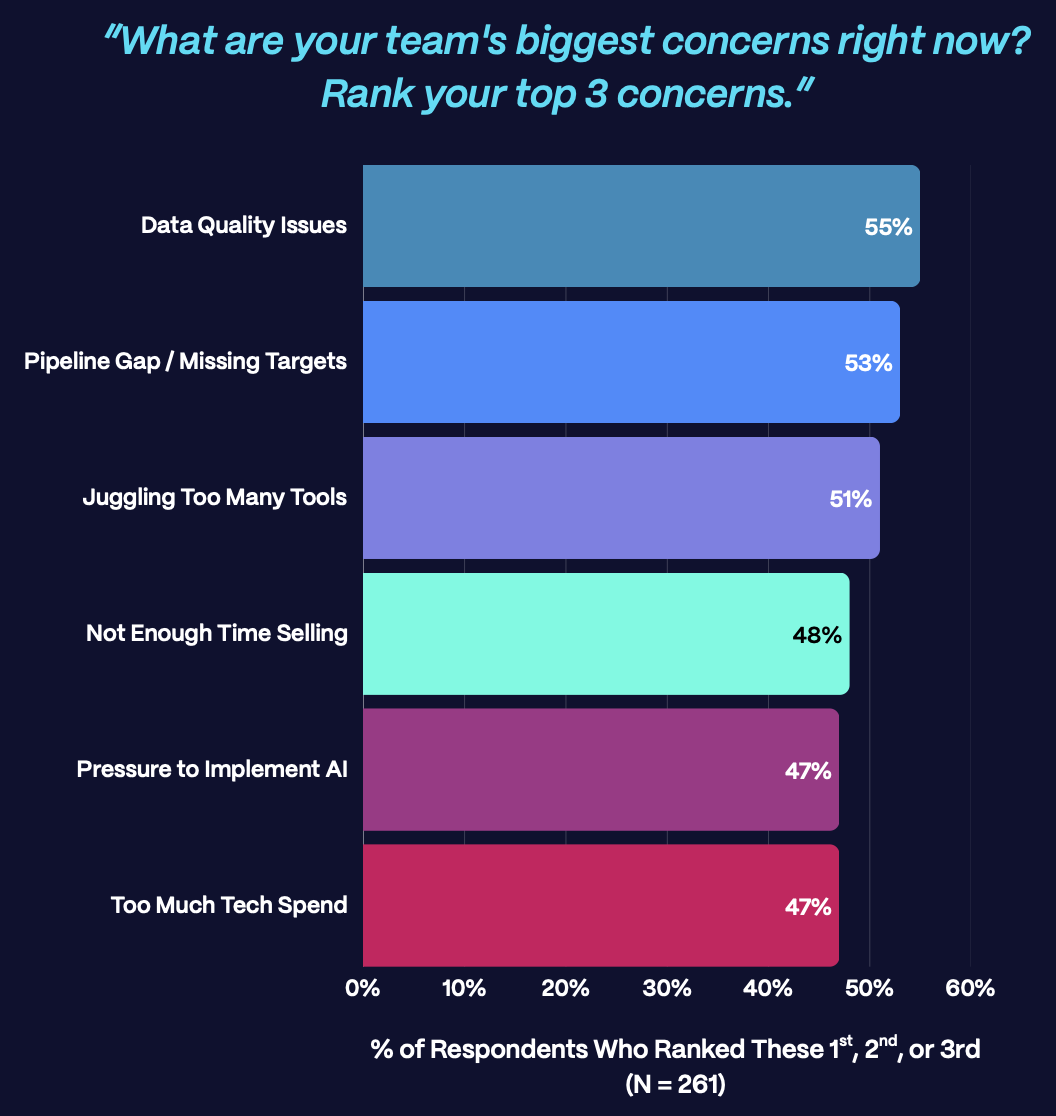
While 55% of all leaders cite data quality as a top concern, these teams have already solved it. Their contact records are current, their firmographic and intent data are clean, and enrichment runs automatically in the background. Instead of guessing who to reach out to, their reps are working from a reliable foundation.
That accuracy pays off. When reps don’t waste time chasing stale leads or reconciling mismatched fields, they gain back hours that compound every week. Reliable data breaks the first link in the doom loop by turning prospecting from guesswork into strategy.
How they unlock efficiency
Once the data problem is solved, top teams address the next chokepoint: workflow friction. Instead of layering on point tools, they consolidate around connected systems where enrichment, sequencing, messaging, and dialing all happen in one place.
Compare that to the rest of the industry. Forty-six percent (46%) of teams use four to six tools for outbound, and another 21% juggle seven or more. The high performers have gone in the opposite direction, replacing fragmented stacks with unified workflows.
That’s also how they’ve tackled the administrative time tax. Across all teams, 58% say reps spend up to 30% of their week on admin, and another 33% say it’s 40–50%. But the top 1% — those with zero admin burden — didn’t get there by working longer hours. They automated CRM updates, enrichment, research, and follow-up so their reps could spend more time actually selling.
How they scale impact
Efficiency alone doesn’t move the needle if teams are focusing on the wrong prospects. The top performers stand out because they’re using AI strategically, not just for content generation but for lead scoring, sequencing, personalization, and prioritization.
Their results show why this matters. Sixty-two percent (62%) of teams using AI report significant or game-changing impact compared to those still relying on manual outreach. These high performers have broken the doom loop:
- Good data enables accurate prioritization.
- Accurate prioritization makes limited selling time more productive.
- Productive selling time generates more pipeline.
In short, the best teams have learned that success isn’t about dialing harder; it’s about architecting smarter systems. They’ve built the foundation, automated the busywork, and trusted AI to handle what humans shouldn’t have to. That’s how they’re outperforming the field.
The takeaway
The playbook isn’t a secret. The teams that are winning today are the ones that fixed their systems first, then scaled their strategy around them. Every improvement built on the last: clean data, streamlined workflows, and confident use of AI.
The next question is how to put those lessons into practice. That’s where we go next: translating what these top performers are doing into steps any team can take to catch up.
{{cta-1}}
Conclusion: where do we go from here?
The question isn’t whether to adapt. The data has already answered that. The real question is how to adapt in a way that’s systematic, sustainable, and measurable.
The path forward is clear, but success depends on tackling the right problems in the right order.
1. Start with the foundation: your data
If your data is unreliable, no technology will fix it. High-performing teams start by improving data accuracy and enrichment because reliable data makes every other step more effective. Clean, current information drives better targeting, more relevant outreach, and smarter prioritization. Without it, even the best automation can’t deliver meaningful results.
2. Consolidate your tech stack
Once data is under control, simplify how your team works. If reps are moving between four or more systems a day, that fragmentation becomes its own tax. Tool sprawl creates handoffs, errors, and unnecessary admin — exactly the kind of work that eats up 20–40% of a rep’s week.
Consolidation doesn’t just save time. It improves collaboration and gives teams a single source of truth. The top-performing organizations have already done this, connecting enrichment, sequencing, messaging, and dialing in one workflow that eliminates busywork at the source.
3. Automate the busywork with AI
AI should handle the repetitive work that keeps reps from selling: data entry, CRM hygiene, research, and enrichment. This isn’t about replacement — it’s about enablement. When automation manages the details, reps gain back hours each week to focus on building relationships and generating revenue.
The 62% of teams already seeing significant results from AI prove that this shift pays off. It’s not experimental anymore; it’s operational excellence.
4. Embed AI across your workflows
Automation alone won’t create scale. To see real results, AI needs to move beyond one-off tasks and into the workflow itself. The top 18% of teams have already embedded AI throughout the outbound motion — from lead scoring and sequencing to personalization and prioritization — so every system learns and improves over time.
5. Involve the right people in tech decisions
Finally, reexamine how your organization makes technology decisions. When tool choices are made exclusively at the top, adoption lags. Bringing SDRs, BDRs, and frontline managers into the process ensures the tools you buy actually work for the people using them. The result is stronger buy-in, cleaner data, and faster returns.
The teams that are already hitting their numbers have made these shifts. They fixed their data first, simplified their workflows, and built trust in automation. The next wave of leaders will follow suit.
The choice isn’t whether to evolve: it’s whether to evolve now or play catch-up later.
Download the full State of Sales Development Report 2025 to explore all the data, insights, and benchmarks that are shaping modern prospecting.
Ready to see what intelligent prospecting looks like?
See how RegieOne works and discover how leading teams generate more pipeline without adding headcount.
FAQs
Read more posts
View all BlogsNeed more help?
If you still have questions, make sure to check out our Help Center: there, you'll find all the tips & advice you'll need to get your team up & running with Regie.ai.






